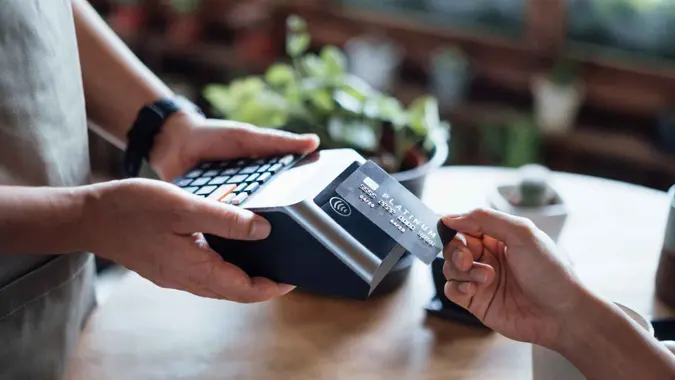Watch Out for This Gas Station Scam: Credit Card Skimmers and How To Avoid Them

Commitment to Our Readers
GOBankingRates' editorial team is committed to bringing you unbiased reviews and information. We use data-driven methodologies to evaluate financial products and services - our reviews and ratings are not influenced by advertisers. You can read more about our editorial guidelines and our products and services review methodology.

20 Years
Helping You Live Richer

Reviewed
by Experts

Trusted by
Millions of Readers
During a time when digital transactions are the norm, credit card fraud has become a significant concern for consumers everywhere. One way criminals steal financial information is through credit card skimmers.
Skimmers are discreetly attached to gas pumps to capture the credit card details of unsuspecting victims (they’re also used at banks and store ATMs). Here’s what you should know about the mechanics of this scam and how you can protect yourself.
Understanding Credit Card Skimmers
Credit card skimmers are small, illegal devices installed by thieves on the card readers of gas pumps. These skimmers are designed to be inconspicuous, making them hard to detect with the untrained eye.
When a credit card is swiped through a compromised machine, the skimmer records all the details stored on the card’s magnetic stripe, including the card number, expiration date, and the cardholder’s name. This information is then used for fraudulent transactions or sold on the dark web.
How Skimmers Operate
Skimmers can be incredibly sophisticated, with some models equipped with Bluetooth technology. This allows the criminals to retrieve the stolen data wirelessly without needing to return to the scene of the crime.
Furthermore, some skimmers are paired with hidden cameras or false keypads to capture the PIN, providing the thieves with everything they need to clone your card or access your bank account directly.
Signs of a Skimming Device
Being vigilant can help you spot potential skimmers. Here are a few things to look out for:
- Physical anomalies. Check for any signs of tampering on the gas pump. If the card reader appears to be protruding more than usual or if the colors or materials don’t match the rest of the machine, it could be a sign of a skimmer.
- Loose components. Wiggle the card reader and keypad. If they move or feel loose, proceed with caution. Legitimate components should be securely attached.
- Security seals. Many gas stations use security seals across the opening of the card reader panel. If the seal is broken or appears tampered with, do not use the pump, and report it to the station attendant.
Protecting Yourself from Skimmers
There are several effective strategies you can use to protect yourself:
- Use credit over debit. Use a credit card or mobile payment options like Apple Pay or Google Wallet when possible. These methods offer better fraud protection compared to debit cards.
- Monitor your accounts. Regularly check your bank and credit card statements for any unauthorized transactions. Early detection is the key to preventing significant financial loss.
- Choose pumps wisely. Use gas pumps that are closer to the store entrance. Thieves often install skimmers on pumps that are harder for the attendant to see.
- Shield your PIN. Always cover the keypad with your other hand when entering your PIN to protect against hidden cameras.
Reporting Suspected Skimmers
If you suspect a gas pump has been tampered with, do not use it. Immediately inform the gas station attendant and consider contacting local law enforcement. By reporting your suspicions, you can help prevent others from becoming victims of this scam.
Bottom Line
Credit card skimmers at gas stations represent a real and present danger to consumers. However, staying informed about how these devices work and protecting your financial information can reduce your risk of becoming a victim.
Always monitor your accounts and don’t hesitate to report suspicious activity. You can combat this threat and ensure your financial security with the appropriate steps.
Editor's note: This article was produced via automated technology and then fine-tuned and verified for accuracy by a member of GOBankingRates' editorial team.
 Written by
Written by 

























